Baroque chess is a chess variant invented in 1962 by Robert Abbott. In 1963, at the suggestion of his publisher, he changed the name to Ultima, by which name it is also known. Abbott later considered his invention flawed and suggested amendments to the rules, but these suggestions have been substantially ignored by the gaming community, which continues to play by the 1962 rules. Since the rules for Baroque were first laid down in 1962, some regional variation has arisen, causing the game to diverge from Ultima.
A fairy chess piece, variant chess piece, unorthodox chess piece, or heterodox chess piece is a chess piece not used in conventional chess but incorporated into certain chess variants and some chess problems. Compared to conventional pieces, fairy pieces vary mostly in the way they move, but they may also follow special rules for capturing, promotions, etc. Because of the distributed and uncoordinated nature of unorthodox chess development, the same piece can have different names, and different pieces can have the same name in various contexts. Most are symbolised as inverted or rotated icons of the standard pieces in diagrams, and the meanings of these "wildcards" must be defined in each context separately. Pieces invented for use in chess variants rather than problems sometimes instead have special icons designed for them, but with some exceptions, many of these are not used beyond the individual games for which they were invented.

Chu shogi is a strategy board game native to Japan. It is similar to modern shogi in its rules and gameplay. Its name means "mid-sized shogi", from a time when there were three sizes of shogi variants that were regularly being played. Chu shogi seems to have been developed in the early 14th century as a derivative of dai shogi. There are earlier references, but it is not clear that they refer to the game as we now know it.
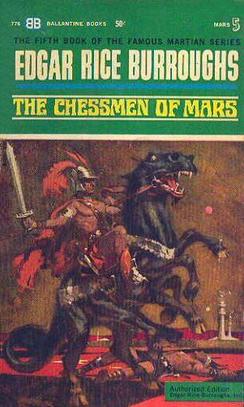
Jetan, also known as Martian chess, is a chess variant first published in 1922. It was created by Edgar Rice Burroughs as a game played on Barsoom, his fictional version of Mars. The game was introduced in The Chessmen of Mars, the fifth book in the Barsoom series. Its rules are described in Chapter 2 and in the Appendix of the book, with an actual game partly described in Chapter 17.
Heian dai shogi is an early large board variant of shogi as it was played in the Heian period. The same 12th century document which describes the Heian form of shogi also describes this variant. Unfortunately, this description does not give enough information to actually play the game, but this has not stopped people from attempting to reconstruct this early form of shogi. A fairly complete and playable reconstruction is outlined here.
Dai shogi or Kamakura dai shogi (鎌倉大将棋) is a chess variant native to Japan. It derived from Heian era shogi, and is similar to standard shogi in its rules and game play. Dai shogi is only one of several large board shogi variants. Its name means large shogi, from a time when there were three sizes of shogi games. Early versions of dai shogi can be traced back to the Kamakura period, from about AD 1230. It was the historical basis for the later, much more popular variant chu shogi, which shrinks the board and removes the weakest pieces.

Tenjiku shogi is a large-board variant of shogi. The game dates back to the 15th or 16th century and was based on the earlier chu shogi, which itself was based on dai shogi.
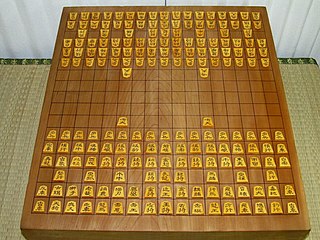
Dai dai shōgi is a large board variant of shogi. The game dates back to the 15th century and is based on the earlier dai shogi. Apart from its size, the major difference is in the range of the pieces and the "promotion by capture" rule. It is the smallest board variant to use this rule.

Maka dai dai shōgi is a large board variant of shogi. The game dates back to the 15th century and is based on dai dai shogi and the earlier dai shogi. The three Edo-era sources are not congruent in their descriptions of the pieces not found in smaller games. Apart from its size and number of pieces, the major difference from these smaller games is the "promotion by capture" rule. A more compact modern proposal for the game is called hishigata shogi.
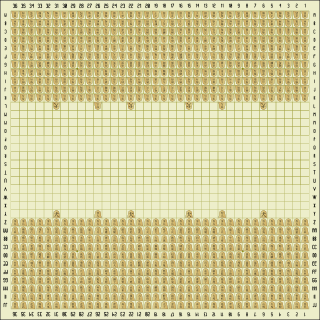
Taikyoku shōgi is the largest known variant of shogi. The game was created around the mid-16th century and is based on earlier large board shogi games. Before the rediscovery of taikyoku shogi in 1997, tai shogi was believed to be the largest physically playable chess variant ever. It has not been shown that taikyoku shogi was ever widely played. There are only two sets of restored taikyoku shogi pieces and one of them is held at Osaka University of Commerce. One game may be played over several long sessions and require each player to make over a thousand moves.

Kō shōgi is a large-board variant of shogi, or Japanese chess. The game dates back to the turn of the 18th century and is based on xiangqi and go as well as shogi. Credit for its invention has been given to Confucian scholar Ogyū Sorai (1666–1728), who had also described the rules of the game in his book, Kōshōgifu (廣象棋譜).

Hexagonal chess is a group of chess variants played on boards composed of hexagon cells. The best known is Gliński's variant, played on a symmetric 91-cell hexagonal board.
Sannin shōgi, or in full kokusai sannin shōgi, is a three-person shogi variant invented circa 1930 by Tanigasaki Jisuke and recently revived. It is played on a hexagonal grid of border length 7 with 127 cells. Standard shogi pieces may be used, and the rules for capture, promotion, drops, etc. are mostly similar to standard shogi. While piece movement differs somewhat from standard shogi, especially in the case of the powerful promoted king, the main difference in play is due to the rules for voluntary and mandatory alliance between two of the three players.
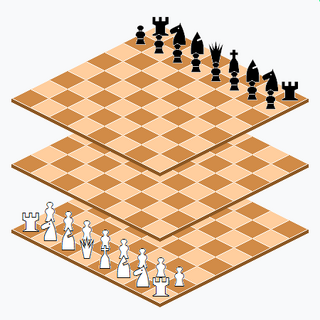
Millennium 3D chess is a three-dimensional chess variant created by William L. d'Agostino in 2001. It employs three vertically stacked 8×8 boards, with each player controlling a standard set of chess pieces. The inventor describes his objective as "extending the traditional chess game into a multilevel environment without distorting the basic game."

Chesquerque is a chess variant invented by George R. Dekle Sr. in 1986. The game is played on a board composed of four Alquerque boards combined into a square. Like Alquerque, pieces are positioned on points of intersection and make their moves along marked lines ; as such, the board comprises a 9×9 grid with 81 positions (points) that pieces can move to.
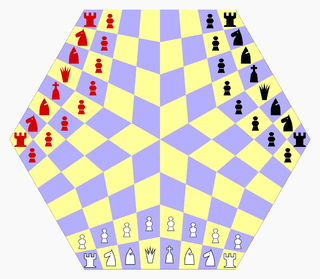
Three-man chess is a chess variant for three players invented by George R. Dekle Sr. in 1984. The game is played on a hexagonal board comprising 96 quadrilateral cells. Each player controls a standard army of chess pieces.

Rollerball is a chess variant invented by Jean-Louis Cazaux in 1998. The game was inspired by the 1975 science-fiction movie Rollerball, specifically the futuristic and violent sport portrayed in the film.

Diplomat chess is a chess variant invented by Carlos Martín-Fuertes in 2003 as a contribution to a Contest to design a chess variant on 43 squares, organised by The Chess Variant Pages. It is played on a circular board with 43 cells, including the center circle which is considered orthogonal and diagonal to every adjacent cell. The game includes a fairy piece called 'diplomat' which instead of capturing can suborn enemy pieces.

Congo is a chess variant invented by Demian Freeling in 1982 when he was nearly 8 years old. His father encouraged him to design a variant using a 7×7 gameboard. Demian was already familiar with chess and xiangqi, and the result blends some features from both. Congo became the second-most popular chess variant at the Fanaat games club in Enschede, the Netherlands.
Betza's funny notation, also referred to as Betza notation, is a compact method to describe the way pieces move in chess-like board games. It is in common use in the world of chess variants. It was originally invented by the American chess master Ralph Betza. There have been several proposals for its extension to games with more complex moves than the original system could handle. Betza notation is used in the XBoard graphical interface for chess-like games, where it can be used to configure the move generator used for highlighting possible moves, and preventing entry of illegal ones. It is more used to write down how a piece moves, rather than the actual notation for the piece. This can be a helpful shorthand for very large chess or especially shogi variants with various types of pieces.





















